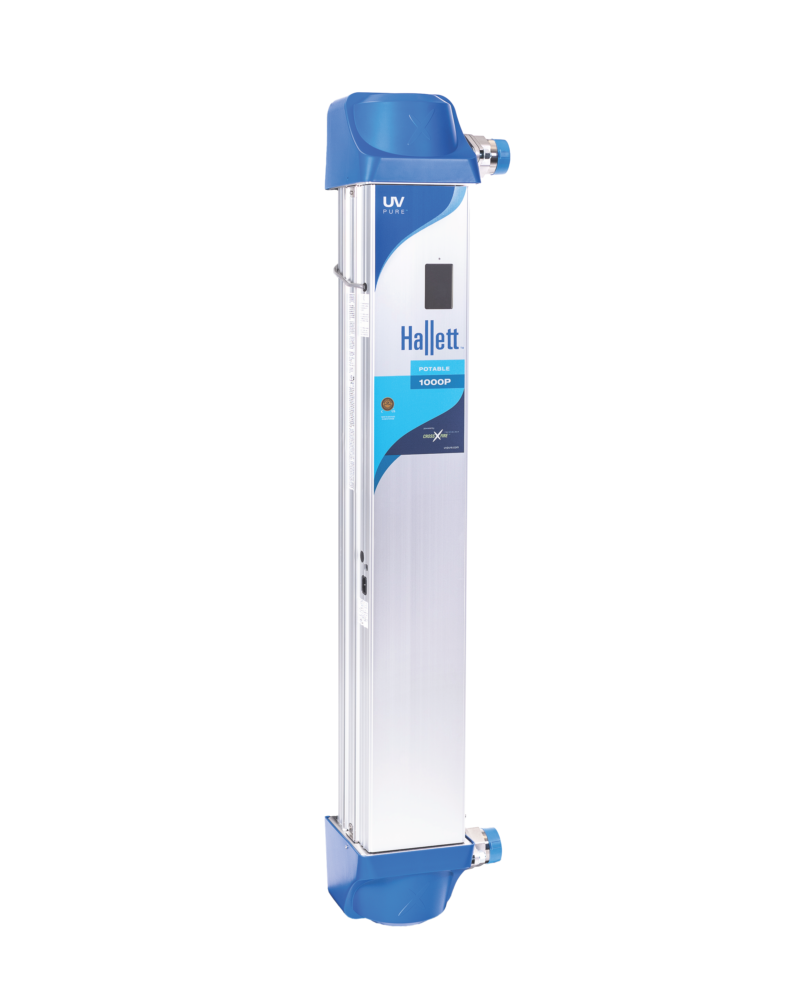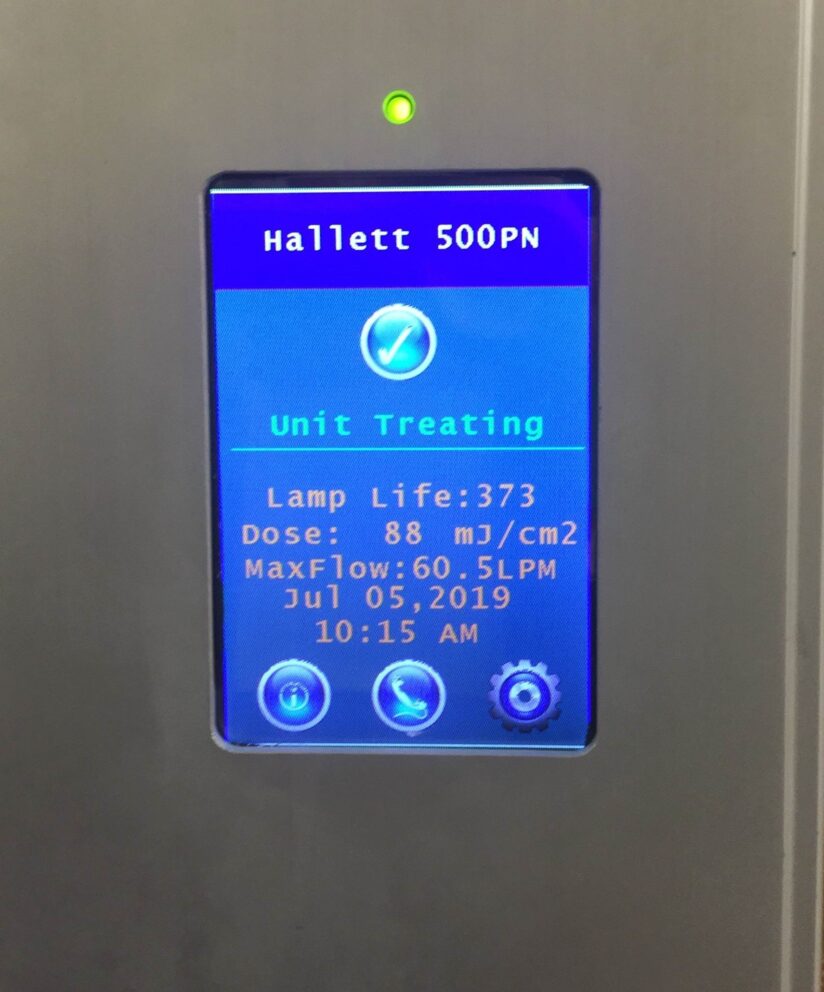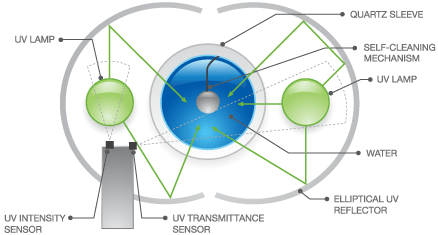A case study on: Rural community adds high UV dose Hallett™ 1000 systems to overcome disinfection challenges from elevated ammonia

System Design Specifications
Application: Potable water treatment
Location: Creelman, SK, Canada
Commissioned: February 2019
Source: Surface water
System: 4 x UV Pure® Hallett™ 1000
(3 x continuous duty, 1 x standby)
Capacity: 30 US gpm (113.5 L/min)
Minimum UVT: 60%
Minimum UV dose: 186 mJ/cm2
Saskatchewan WSA Permit No.:00071291-00-00
Executive Summary
Varying ammonia concentrations in the water supply are a constant challenge for the small village of Creelman, Saskatchewan, which is home to about 120 residents. For decades, ammonia has impeded the water treatment plant’s chlorine system to consistently achieve primary disinfection and sufficient free chlorine in the distribution system. The situation has led to many boil water advisories, at times lasting several months, until the ammonia concentration in the source water drops to a level that the plant can cope with.
Chlorine disinfection can become difficult when ammonia concentration is as low as 0.2 mg/L. At this level, ammonia begins reacting with chlorine to form chloramines, which can also cause taste and odour issues. Though chloramines do provide disinfection, much more contact time is required so this method is not recommended to be used for primary disinfection by the Saskatchewan Water Security Agency (WSA.)
Creelman’s situation escalated in 2017 when ammonia levels in the pond that provides the community’s potable water increased to as much as 2.5 mg/L during the winter months. Breakpoint, or super-chlorination, was one way to overcome the high ammonia level, but the process greatly increases chlorine consumption and operating costs and could cause the plant to exceed the Maximum Use Level (MUL) of the chemical as set by NSF/ANSI Standard 60.
Creelman looks for alternatives to chlorine for primary disinfection

UV Pure® local representative, Randy Schatz of Element Water Systems, suggested a more efficient and cost-effective alternative to chlorine for the plant’s disinfection process. Schatz proposed the UV Pure Hallett™ 1000 system for the Creelman Water Treatment Plant (WTP), an advanced, low-maintenance unit that is EPA-certified to provide a powerful UV dose of 186 mJ/cm2 and achieve 4-log inactivation of viruses, including adenovirus.
The Hallett systems could effectively provide primary disinfection of the source water regardless of the ammonia concentration, eliminate the need for breakpoint chlorination and the associated risk of MUL exceedance. Chloramines would still form once chlorine is added for secondary disinfection, but the method is acceptable by the WSA as long as the total chlorine level in the distribution system is maintained at no less than 0.5 mg/L. According to the US Environmental Protection Agency, chloramines may also offer some advantages over chlorine since they provide longer lasting disinfection in the distribution system and form fewer potentially harmful disinfection by-products than chlorine.
Schatz worked collaboratively with the community’s plant operator, its consulting engineering firm and the WSA to obtain the required approvals and to design a multi-unit Hallett 1000 system that would align with the plant’s treatment process and fit the available space. Once the approvals were in place, Schatz and his team installed and commissioned four EPA-certified Hallett 1000 systems at the Creelman WTP capable of providing a total treatment capacity of up to 30 gpm (113.5 L/min).
Hallett systems simplify treatment and operation
The easy-to-operate Hallett systems are an ideal choice for small- and medium-sized water and wastewater treatment systems, since they incorporate several innovative design features that help minimize oversight and maintenance requirements, increase affordability and enhance reliability.
One major advantage is new lamp and ballast technology that enables the UV lamps in the Hallett systems to perform up to a dozen on/off cycles per day. This is especially important for a small system like Creelman here water is treated intermittently. The Hallett 1000 systems in Creelman are configured to operate only when the plant’s filter system is running, otherwise the UV system is shut down, which reduces electricity consumption and extends lamp life.
Crossfire technology improves performance, reduces maintenance, protects public health
UV Pure Crossfire™ Technology provides many other advantages too. Each Hallett system is equipped with dual UV lamps that are mounted vertically in air, so lamp changes can be performed quickly and without the need to drain the system. The Crossfire system also adds elliptical reflectors that enable UV light energy to be redirected back through the water column, eliminating shadowing and targeting pathogens from every angle.
An automatic cleaning system prevents scaling and biofouling of the quartz sleeve and dramatically extends the intervals between manual cleanings. The operator of the Creelman WTP reported that even after a year of operation, the automatic cleaning system maintained the quartz sleeves in pristine condition and no manual cleanings were required.
Innovative sensor technology in the Hallett 1000 system also provides a reliable and affordable way to ensure water quality and safety for Creelman residents. Each system is equipped with four integrated sensors that continually monitor UV transmittance (UVT) and UV intensity (UVI), which helps budget-conscious water

plants avoid purchasing costly external UV sensors. Performance data from the Hallett systems can be remotely monitored by the operator in real time, thanks to 4-20 mA/Modbus output capabilities that are an optional feature of the current generation Hallett systems.
Like the Hallett UV lamps, the sensors are mounted in air, which prevents the sensor fouling, frequent cleaning and monthly calibration issues that conventional systems experience. If the sensors detect that UVT or UVI measurements are not within specified parameters, the system will shut down until the operator can correct the issue and restart the system.
To download the case study, click here.


